#Jiajing Emperor
Text
youtube
There are A LOT of weird, nutjob despots throughout history....This one tho seems pretty far out there.
4 notes
·
View notes
Quote
The Jiajing Emperor (1507–1567) was the twelfth emperor of the Chinese Ming dynasty. Every day he would drink a concoction called ‘red lead’, made from the menstrual blood of virgins that he believed would prolong his life. The girls were aged between eleven and fourteen and were treated so cruelly that in 1542 they attempted to assassinate the emperor. Though he was badly injured, the emperor survived, and his attackers, along with their families, were sentenced to death by slow slicing. The emperor continued to drink red lead for the rest of his life. Twat.
A Curious History of Sex (Kate Lister)
... Girls aged 13–14 were kept for this purpose, and were fed only mulberry leaves and rainwater. Any girls who developed illnesses were thrown out and they could be beaten for the slightest offence. ...
wiki: Palace plot of Renyin year
#A Curious History of Sex#Kate Lister#ch: Period Drama: A History of Menstruation#history#Jiajing Emperor#China#Ming dynasty#Palace plot of Renyin year#women#menstruation#abuse#books#quotes#V
9 notes
·
View notes
Photo
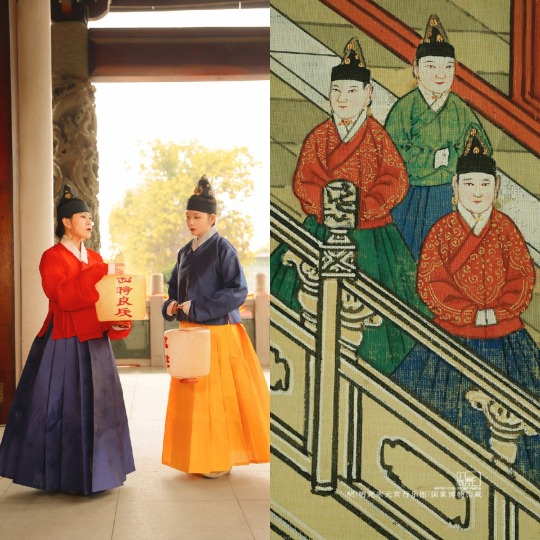
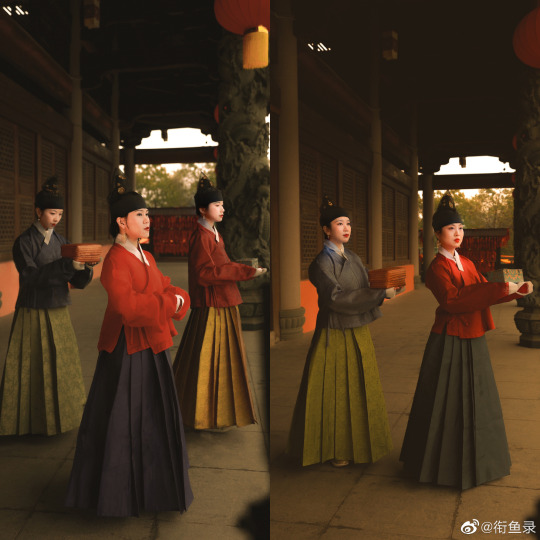



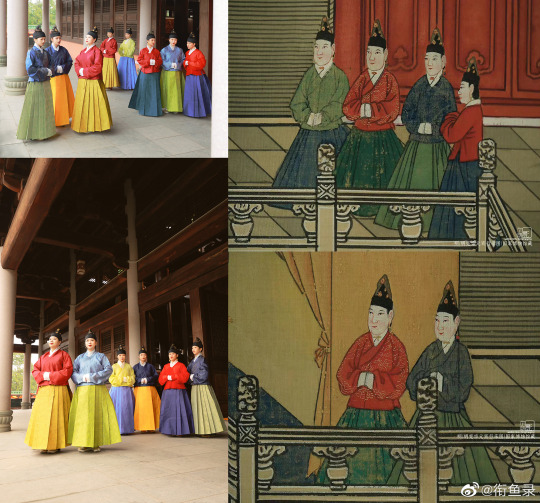

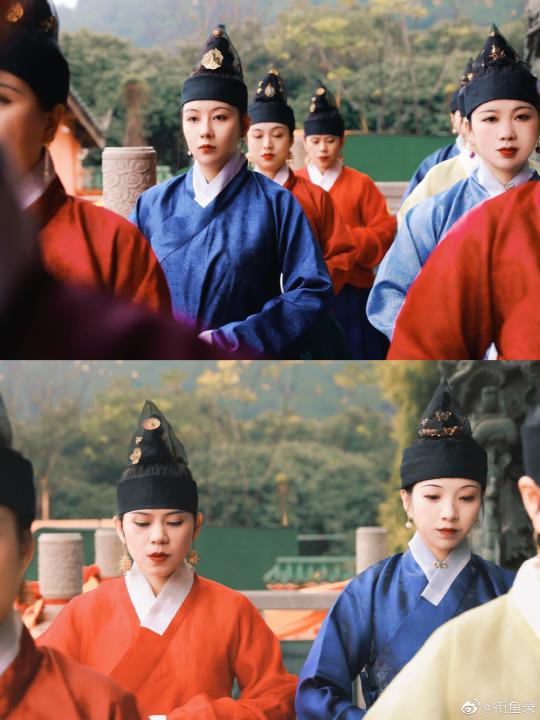
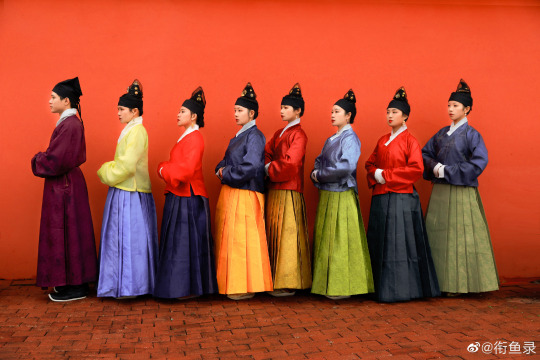
【历史文物参考】
Chinese Ming Dynasty Painting(1485 CE):【明宪宗元宵行乐图/Ming Emperor Xianzong Enjoying the Lantern Festival (part)】showing court lady in the ming dynasty
※ Women with gold patterns in Hanfu (top) had titles/rank in the court of the Ming Dynasty, and they may be imperial concubines, princesses, etc.
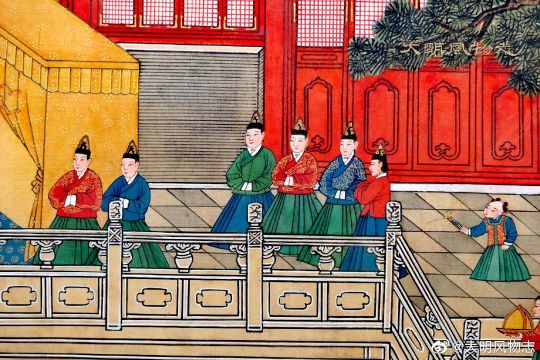
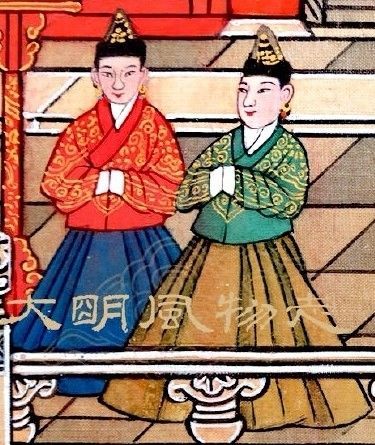




[Hanfu · 汉服]Chinese Ming Dynasty Chenghua era(1465-1487 AD) Traditional Clothing Hanfu & Hairstyle
【About horsehair skirt (马尾裙) petticoat】
A horsehair petticoat (马尾裙) is a petticoat that is worn under the skirt to give it a puffy appearance. This kind of petticoat came from Korea Joseon at that time.
❗ However, it would be wrong to say that the entire outfit above is Korean origin as someone claim.
In Ming Dynasty record "寓圃杂记/Yu Pu Notes" By Wang Kai王锜 emphasizes that this style of clothing (马尾裙horsehair petticoat) is a kind of ominously strange clothing , which is what the ancients called "服妖(A derogatory term that describes people wearing weird clothing is bad symbol)". It is only popular among rich and uneducated people, and will let decent people look down on, the original words are " 然系此者惟粗俗官员、暴富子弟而已,士夫甚鄙之,近服妖也 "
Horsehair petticoats are popular in Beijing. Demand was low at first, and local production was impossible and unnecessary. They are all imported from Korea Joseon. When it becomes popular, even men like to wear horsehair petticoats under their robes, and the demand and market will naturally increase, so localized production began. But the number of horses is limited, and the most important raw material, horse hair, is not easy to obtain.
So some people went to the army camp to steal the horse hair of the army horse, which made the army horse look thin and bad.
❗In the Early Emperor Hongzhi era,the officials reported these incident to the Emperor Hongzhi(1470-1505)of the Ming Dynasty said”京中士人好著马尾衬裙,因此官马被人偷拔鬃尾,有误军国大计。乞要禁革”Saying that such behavior is not good for the country and suggest to ban horsehair petticoat. So Emperor Hongzhi make an order to banned people wearing Horsehair petticoats
Since then, this horsehair petticoat gradually disappeared from China history
❗ It is worth mentioning that even in the period when horsehair petticoats were popular, not everyone wore horsehair petticoats, as shown in the book "释氏源流应化事迹" in the Chenghua era of Ming Dynasty (AD 1465-1487): ( Women that not wear horsehair petticoats)
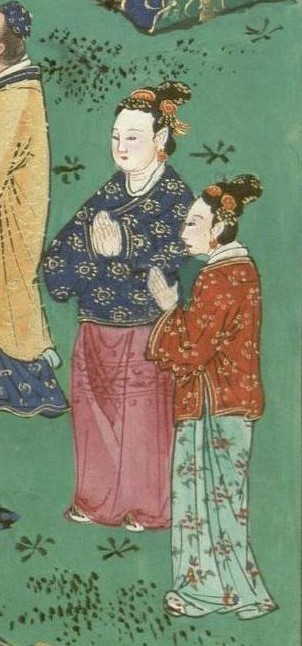
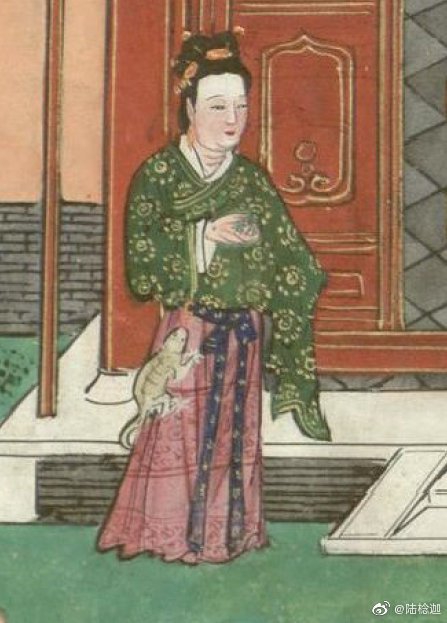

After Emperor Hongzhi banned the wearing of horsehair petticoats (back to the silhouette of Hanfu in the Ming Dynasty), as shown below
Murals in the tomb chamber of Zhengde period (1506-1521) - Jiajing period (1522-1566)::

_______
💡 Produce: @衔鱼录
📸Photo: @超级方便MAN
🎥Post-production : @还是叫我雪影吧
🔖Hanfu Research: @玩泥巴的豆角 @邈邈阁的颜掌柜
🧚🏻 Model : @还是叫我雪影吧 @曾嚼子 @记不住密码的小基崽 @NanFu_南赋吖 @玩泥巴的豆角 @纭澈 @言言衍晏 @子可_POTTERY @祁祁萝祁萝贰祁
💄Makeup Director: @还是叫我雪影吧
🧵Tailor: @邈邈阁的颜掌柜
🏮Lantern provider: @纭澈
CC organization: @南宁汉服小组 @汉洋折衷bot @大朙时尚搭配频道 @大明穿搭bot @说给大明服饰
🔗微博:https://weibo.com/3962795866/MrDftbHIT
_______
#chinese hanfu#Ming Dynasty Chenghua era(1465-1487 AD)#hanfu#chinese traditional clothing#chinese fashion history#China History#chinese#historical fashion#historical hairstyles#Chinese Costume#chinese culture#hanfu accessories#hanfu history#Zhengde Emperor era(1506-1521)#Jiajing Emperor era(1522–1566 A.D)#《释氏源流应化事迹》#寓圃杂记/Yu Pu Notes#明宪宗元宵行乐图/Ming Emperor Xianzong Enjoying the Lantern Festival#汉服#漢服#Horsehair petticoats
300 notes
·
View notes
Text
On the night of April 30, 1541, the Ming Ancestral Temple in Beijing was struck by lightning and burned to the ground. [...]
[T]he fires forced the Jiajing Emperor to resurrect one of the dynasty’s most expensive, difficult, and destructive projects: the logging of old-growth timber in the far southwest of China. Disaster struck again in 1556, when fires burned the Three Halls that form the central axis of the Forbidden City. The Three Halls burned yet again in 1584. [...] Yet the lightning strikes in Beijing were also a disaster for the old-growth forests of the southwest, where the logs to build the palaces had first been cut in the early 1400s. As logging supervisors soon learned, ancient trees could not be felled on a regular basis. Officials pressed ever deeper into the gorges of southern Sichuan and northern Guizhou to find them, bringing massive transformations to the environment in the process.
---
The foundations of Beijing were laid between 1406 and 1421 by the Yongle emperor, a junior son of the Ming founder, who moved the court to his personal appanage in north China. [...] Grasping the sinews of power that connected his court to far-flung regions of the empire, Yongle pulled one million laborers to Beijing to build his palaces. Because the weight of Chinese buildings is carried by their pillar-and-beam frameworks (liangzhu), monumental buildings required monumental trees (Figure 2). So Yongle also dispatched a similarly large labor force to the old-growth forests of the far southwest to cut the fir (Cunninghamia lanceolata) and nanmu (Phoebe zhennan) that grew straight and tall enough to be used for imperial construction.
We cannot be certain just how many logs were cut to build Beijing, but the figure must have been astounding. In 1441, two decades after the completion of the project, 380,000 large timbers were left over from the earlier construction. By 1500, these too were gone, used for repairs or too damaged by rot to be used for construction purposes.
---
In the sixteenth century, logging officials wondered how their predecessors had been able to obtain so many giant timbers. Li Xianqing, who supervised more than 40 logging sites in the 1540s, noted that large trees could still be found, but they could only be transported out with great difficulty and at great expense. The majority had to be discarded as hollow or insect-damaged. Even when a quality log was found, it took five hundred workers to tow a log over mountain passes.
Skilled craftsmen were on hand to build “flying bridges” (fei qiao), stone-lined slip roads, and enormous capstans (tianche) to tow the logs up slopes (Figures 3 and 4). In the remote forests of the southwest, loggers faced attacks by snakes, tigers, and “barbarians” (manyi); “miasmatic vapors” (yanzhang, probably malaria); storms, forest fires, rockslides, and raging rivers (Figure 5). Labor teams had to carry their own food and often starved. At the rivers, logs were tied into massive rafts bound with bamboo for buoyancy, towed by teams of 40 men, and then launched on the three-year, three-thousand-kilometer journey to Beijing (Figure 6). Only a small fraction of the trees reached the capital in a condition where they could be used for palace building.
---
Expeditions exceeded their budgets up to fiftyfold.
One official remarked, “the labor force numbers in the thousands; the days number in the hundreds; the supply costs number in the tens of thousands each year.” Another saying held that “one thousand enter the mountains, but only five hundred leave” (rushan yiqian chu shan wubai). To make matters worse, logging mostly occurred within territory that was under only loose Ming control [...].
---
The Yongle Palaces were said to replicate the otherworldly atmosphere of the old-growth forests where their pillars originated. The presence of these timbers in Beijing linked the capital, materially and symbolically, to the southwestern landscape of cliffs and gorges where the trees had grown.
But ancient sentinel trees could not be reproduced on demand. The fifteenth-century logging project was a millennial event, removing the growth of hundreds or even thousands of years. Later officials were forced to come to terms with the transformations their predecessors had wrought in the ancient forests. Eventually builders had to switch to smaller, commercially available timber, using ornate artisanship and commercial efficiency to substitute for the austere majesty of the early Ming palaces, and the thousands of years of tree growth on which they rested.
---
All text above by: Ian M. Miller. “The Distant Roots of Beijing’s Palaces.” Rachel Carson Center for Environment and Society, Environment & Society Portal, Arcadia no. 39. Autumn 2020. [Bold emphasis and some paragraph breaks/contractions added by me. Presented here for commentary, teaching, criticism purposes.]
408 notes
·
View notes
Note
How would the whole succession thing work, leaving aside LMK (the series has its own rules how some things work, I guess?). Like, I always thought Erlang would be the most suitable candidate. Even though we know he is rebellious. Although I know that the Jade Emperor has many children.
Hmmm...where to start?
Though S4's execution of it falters, the idea that the Heavenly Emperor can be replaced is not entirely without basis.
There is a very funny example in the Tang dynasty You Yang Za Zu, where this guy named Zhang Jian basically became the Heavenly Emperor via a magical bird and Grand Carridge Theft.
An earlier work, the Northern-Southern dynasty 殷芸小说, also had this guy who died and came back to life recount his meeting with the Heavenly Emperor, where he asked the officials nearby if this was "Heavenly Emperor Zhang" of old, and they were like "Nah, that guy's long gone, it's Cao Mingdi now."
(Who is a historical emperor of the Wei dynasty, btw.)
However, other than that, there isn't much else, so to answer this question, we must look to IRL imperial successions for inspirations.
First, only male heirs are eligible for the throne, which rules out all of JE's daughters.
Second, the eldest son/son of the empress, as well as said son's male firstborn, is preferred. However, you can find a number of exceptions to that in Chinese history, when an emperor chose a younger son as his heir, usually because the firstborn was seriously unsuitable to rule, or he needed a stronger and more talented successor to deal with the mess to come.
When an emperor has no heir whatsoever, the next best choice would be one of the emperor's brothers. And if the emperor has no brothers either, we'll finally get to some other princes in the royal family. For example, the eleventh emperor of the Ming dynasty, Jiajing/Shizong, was the cousin of the guy that came before him.
In JTTS, the JE does have a crown prince, who quarreled with Huaguang and got beaten up. A more outlandish and fantastical case of someone related to JE is Emperor Zhenwu in JTTN, who is one of JE's three souls incarnate.
Under the dynastic succession system, whether Erlang would be a viable candidate depends on if you take JTTS a/o JTTN as canon.
Outside of that, if the only heir is a little kid, the late emperor's wife/experienced male relative can also rule as dowager/regent in his stead.
But also: why do we need a single heir to succeed JE, anyways? Can't we just, y'know, do away with the imperial dynastic system altogether and reform the Celestial Bureaucracy into a slightly more modern one?
#chinese history#journey to the west#lego monkie kid#chinese mythology#chinese literature#jade emperor#erlang shen
20 notes
·
View notes
Photo




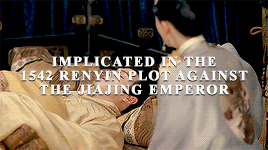

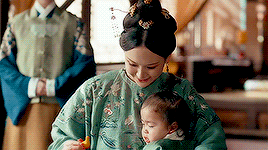
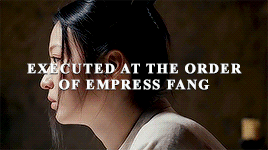
Consort Duan 端妃 (duān fēi),of the Cao Clan, was a Ming Dynasty concubine of the Jiajing emperor. Lady Cao was born in Wuxi, modern Jiangsu Province. She was one of JIajing Emperor’s favourite consorts. In 1536, Lady Cao gave birth to the emperor's first daughter Zhu Shouying, Princess Chang'an. The same year, she was promoted to Imperial Concubine Duan. In 1537, Imperial Concubine Duan was promoted to Consort Duan. She gave birth to the emperor's third daughter in 1539, Zhu Luzheng, Princess Ning’an. The Jiajing emperor was a notoriously short-tempered, harsh man with many enemies, and in late 1542 several maids, despairing of his cruelty, attempted to assassinate him. This event has come to be known as the palace incident of the renyin year [1542] (renyin gong bian) or the incident of the palace maids. That night, the emperor had fallen asleep in the chambers of Consort Duan, who withdrew with her attendants, leaving him alone. The palace maids entered the room, tied a knot in a silk curtain cord, and slipped it around his neck; they also began to stab him in the groin with their hairpins. Someone among them panicked, Empress Fang was alerted, and a physician was summoned. The emperor remained unconscious until the following afternoon and, acting on his behalf, Empress Fang ordered that all of the women involved be executed immediately. As the attack had taken place in Consort Duan's palace, the empress determined that she had conspired with the palace women and sentenced her to death by slow slicing in the marketplace. The Jiajing held Empress Fang responsible for the death of his favorite, Consort Duan, thinking that she couldn’t have been involved, and when the empress was trapped in a palace fire in 1547 he refused to agree to her being rescued, leading to her death.
Source: Lee, Lily Xiao Hong; Wiles, Sue. Biographical Dictionary of Chinese Women, Volume II (University of Hong Kong Libraries Publications), Zhang Tingyu, (1739). History of Ming, Volume 114, Historical Biography 2, Empresses and Concubines 2.
Happy belated birthday @misssylvertongue!
#women in history#historyedit#cao duanfei#曹端妃#consort duan of the cao clan#ming dynasty#16th century#misssylvertongue#sorry this took so long!#hope you like it <3#her life was so sad#the fact that so many women died while jiajing lived to abuse even more women is so tragic#*mine
144 notes
·
View notes
Note
please don’t fn kill me but Marius de Romanus and his overall relationship with Armand 🔥
Bonus round: David Talbot x Marius as a ship🔥
Thank you and please enjoy your day
my aaaabsolutely hottest take is that the fandom is insanely selective about what problematic stuff they think "counts". everyone's got a set number of things that they accept from the canon and things they don't. they have things they de-rice-ify and things they don't. e.g. I have NEVER seen the insanely pornographic description of lestat eating the children in the iwtv novel ever brought up because it's gross so we all pretend it's not real. I think it's fine people do this. I don't even think people SHOULD try to have a consistent read of the vampire chronicles books. I think that if we did, it would be an indictment of them and not a compliment. For example, truth be told, I hate most pixar movies. hate them. any film that is getting EXACTLY the same audience reaction from virtually every single audience member at exactly the same points with surgical precision might be an excellent commercial product but it's meaningless art.
however, it should never be an expectation that there are any components that people "have" to regard in a specific way, and especially for this specific property that is asinine. YOUR way of chewing over them and what YOU think about them is what matters. if it gets YOU horny enough to bring yourself to completion. there should be no fucking tribunal where we all get together and decide what anyone else has to think. I like Devil's Minion because it's fucking sick. I think gabrielle eating polar bears (canon as per Armand) is fucking funny in a way that I wouldn't think some random asshole shooting polar bears is funny. i think it's funny the fandom never thinks about how louis burning the fuck out of antoine was pretty fucked up from antoine's point of view. i think it's fine louis/claudia is canon in the books because she IS an adult, and no number of derivative creepy hentai visual novels will change that, and in fact it's cruel to consider book-Claudia to be a child because for her it's basically a medical condition.
I do however think that a lot of people in this fandom 1) haven't really read many older books and 2) maybe haven't read many books at all. hell, maybe 3) haven't even read these books. some of the interpretations strike me as extremely strange, particularly because i'd argue some of the canon events are worse in a context people sometimes don't seem to be aware of. or every once in a while someone will say something about one character and then be convinced e.g. khayman is smol cream puff and I'm like... hmm. hmm. sybelle for all intents and purposes apparently basically owns living benjamin and i'm not sure i've ever seen anyone worry about it beyond the intense discomfort with the benjamin character overall
anne rice loved historical fiction (which also, I feel inclined to add, was a lot harder to write in the 1990s than it is today because we have information resources that are just INSANE compared to then--you should see what a doctorate looked like in 1995 vs 2022). there are conceits intrinsic to historical fiction. you don't have to like them but people who read historical fiction have a tacit understanding of them. I actually read far less historical fiction than I read nonfiction about history--and not just american or eurasian history. (in the court of the jiajing emperor circa 1547, the 300+ new concubines were between 11 and 14). 'the past is a foreign country' in-fuckin'-deed, not just in terms of the periods the books describe but the books themselves. i just posted an article about a family that took their kids on a sailing trip around the world's oceans in the 1970s and it is UNFATHOMABLE to someone today. and that's living history. when my grandmother took my dad and his siblings to tunisia in the late 1960s, my dad disappeared for 3 DAYS. he was 14. and his mom barely cared, assumed he'd show up again at some point, which obviously he did. my other grandmother's cousin was beheaded in the yard in the 1930s in a rural area and back then crimes like that just were not solved. those things are living memory. you just have to decide if you think a 2020s lens on a 90s book about the 1790s means the content is disqualifying and if the answer is "yes" you are wholly entitled to that, but it is not a requirement for any other segment of the readership
i didn't care about marius at all when i read tvl/qotd/tva in... whatever fucking year a million billion years ago i read them the first time (in catholic school lmao), but at this point i'm stubbornly contrary about it because I think most of the reaction is knee-jerk and reflexive, predicated on tumblr's paper-thin politics, and especially crazy in the sense of what the show now "has" to do. the show didn't even make louis a white slaveowner, thank god! they don't "have" to do shit with anyone. for accountability? FOR ACCOUNTABILITY?? are you high?? accountable to whom, for what, when bandying about with these blights on humankind? anyway the showrunners can change anything they want. they might even have bianca not sleep with an "underage" armand, ooohhhh something i've seen mentioned all of fuckall number of times (thats different because blah blah blah blah blah). and there doesn't even seem to be a downside to turning benjamin or sybelle, so people going on about that part like... yeah, there really should have been, but "should have been" is also kind of antithetical to how this specific canon operates. these books are so fucking FRUSTRATING! but what happened, happened. engage with your canon, but be able to separate out canon-canon. this isn't something that's unique to me and these books, it's most of what killed my interest in my last fandom. take whatever read you want, but learn to differentiate what the canon did and what you would have preferred it did.
armand's relationship with marius is very very complicated and very very interesting but for virtually none of the reasons the fandom pays the remotest attention to. rice was really good at balancing out why people became vampires and what that means and then how they avoid the intense attrition associated with the lifestyle and their various absolutely crippling personality flaws and mental illnesses and that is all over how those two interact. and guess what! as soon as you filter them into "good vampires" and "bad vampires" you have broken the entire world these characters exist in. you have thematically broken it. you have irrevocably and irretrievably broken what makes these books interesting.
david is boring. actually my ship of choice for marius is probably thorne. i think there's a ton of meaty thematic shit in there.
e: as an aside, in life you will have to learn to navigate and negotiate within power structures. they are not going anywhere. the other obsession with perfectly equal relationships etc-- you can idealize that, and that's great. the books aren't about a world where that will be the situation between virtually anyone, and it's rarely if ever the situation in reality either. this is more a loustat comment but it bleeds into everything.
28 notes
·
View notes
Photo

Empress Xiaoke (孝恪皇后; 1510–1554) of the Du clan, was a concubine of Jiajing Emperor of the Ming dynasty and the mother of Zhu Zaiji, the Longqing Emperor.
6 notes
·
View notes
Text
Longjing tea
Longjing tea, a famous specialty product in Zhejiang Province, is a product of China's National Geographical Indication.
The premium Longjing tea is flat, smooth and straight, the color is green and smooth, the aroma is fresh and high, the taste is fresh and sweet, and the bottom of the leaves is delicate and blooming.
In 2001, the State Administration of Quality Supervision officially approved "Longjing tea" as a protected product in the area of origin.
Longjing tea features:
Longjing tea is unique in the world for its green color, beautiful shape, fragrant and mellow taste. It ranks first among the top ten famous teas in China.
The premium Longjing tea is flat, smooth and straight, the color is green and smooth, the aroma is fresh and high, the taste is fresh and sweet, and the bottom of the leaves is delicate and blooming.

Historical Origins:
Before the Sui and Tang Dynasties, Hangzhou tea culture was in the rising stage. During the Three Kingdoms and Jin Dynasties, the economy and culture on both sides of the Qiantang River gradually developed, Lingyin Temple was built, and religious activities such as Buddhism and Taoism gradually became popular. After the opening of the Beijing-Hangzhou Grand Canal in the Sui Dynasty, Hangzhou, due to the geographical convenience of water and land transportation, became a "rich and famous city" in the southeast where products gathered and scattered. At this time, tea was widely cultivated in Hangzhou.
During the Northern Song Dynasty, the Longjing tea area had initially formed a scale. At that time, the "Xianglin Tea" from Xiatianzhu Xianglin Cave in Lingyin, the "Baiyun Tea" from Baiyun Peak in Shangtianzhu, and the "Baoyun Tea" from Geling Baoyun Mountain were listed as tribute. During the Jiajing period of the Ming Dynasty, there was a record that "the tea in Hangzhou County is not as good as the production of Longjing, and the fine buds before the rain, whichever is a flag and a gun, are especially treasures".
In the Yuan Dynasty, Longjing tea had a good reputation. Yu Ji, a tea lover, wrote a tea drinking poem "You Longjing". In the poem, "Wandering on the Longjing, the clouds are clear. The golden buds are fried, and the three swallows can't bear to rinse." widely sung.
In the Qing Dynasty, Emperor Qianlong went to Jiangnan six times, and went to Longjing four times. He wrote six imperial poems about Longjing tea, and he personally named "Eighteen Royal Tea Trees", raising Longjing tea to the supreme status.
After the Republic of China, Longjing tea gradually became the first famous tea in China.

The efficacy of Longjing tea:
1. Exciting effect: The caffeine in tea can excite the central nervous system, help people to invigorate their spirits, improve their thinking, eliminate fatigue and improve work efficiency.
2. Diuretic effect: The caffeine and theophylline in tea have diuretic effect and are used to treat edema and water stagnation. The detoxification and diuretic effects of black tea and sugar water can be used to treat acute jaundice hepatitis.
3. Strengthen the heart and relieve spasm: Caffeine has the effect of strengthening the heart, relieving spasm and relaxing smooth muscle, can relieve bronchospasm and promote blood circulation. It is a good auxiliary drug for the treatment of bronchial asthma, cough and phlegm, and myocardial infarction.
4. Inhibition of arteriosclerosis: Tea polyphenols and vitamin C in tea have the effect of promoting blood circulation and removing blood stasis to prevent arteriosclerosis. Therefore, among people who drink tea regularly, the incidence of hypertension and coronary heart disease is lower.
5. Antibacterial and antibacterial effects: The tea polyphenols and tannic acid in tea act on bacteria, which can solidify the protein of bacteria and kill bacteria. It can be used to treat intestinal diseases, such as cholera, typhoid, dysentery, enteritis, etc. If the skin is sore, festering and oozing pus, and the skin is broken by trauma, rinse the affected area with strong tea, which has anti-inflammatory and bactericidal effects. Oral inflammation, ulceration, and sore throat can also be treated with tea.
6. Weight loss effect: Various compounds such as caffeine, inositol, folic acid, pantothenic acid and aromatic substances in tea can regulate fat metabolism, especially oolong tea has a good decomposition effect on protein and fat. Tea polyphenols and vitamin C can reduce cholesterol and blood lipids, so drinking tea can lose weight.
7. Anti-caries effect: tea contains fluorine, fluoride ion has a great affinity with the calcium of teeth, and can become a kind of "fluorapatite" which is more insoluble in acid, just like adding a protection to teeth layer, which improves the ability of teeth to resist acid and caries.
8. Inhibition of cancer cells: According to reports, the flavonoids in tea have different degrees of anti-cancer effects in vitro, and vitexine, morin and catechin have stronger effects.
9. The effect of promoting body fluid and quenching thirst, refreshing and improving thinking, digestion and greasy, anti-inflammatory and detoxification.
10. The antioxidant effect is because tea has antioxidant, anti-tumor, and lower blood cholesterol and low-density lipoprotein content, inhibits blood pressure, inhibits platelet aggregation, antibacterial, and anti-allergic products.
11. Longjing green tea contains more chlorophyll, amino acids, catechins, and vitamin C than other teas. It is rich in nutrients, and has the functions of quenching thirst, refreshing, quenching thirst, and reducing neutral fat and cholesterol in the blood. It has anti-oxidation, anti-sudden mutation, anti-tumor, lowering blood cholesterol and low-density lipoprotein content, inhibiting blood pressure rise, inhibiting platelet aggregation, antibacterial, anti-allergy and other effects. If it is brewed with Hangzhou Hupao spring water, the fragrance is clear and the taste is crisp, and it is known as the "double must" of Hangzhou.
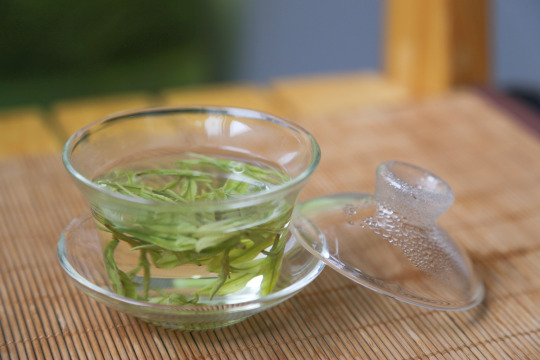
4 notes
·
View notes
Link
#currently reading#i need a fucking two-semester course on the ming dynasty to fully appreciate this boook but damn#meng-dada go off queen#meng xi shi#tian xia#it's so far given me more whump than Chenghua but less romance#SOMEHOW.#SOMEHOW IT'S GIVING ME LESS FOOD THAN MOTHERFUCKING VANILLA UNCLES SUITANG#okay no no i hear it gets much sexier#there's actual smut in this#it's just the fact that for a whole third of the novel the gong is less than 10 years old fnsjdnfksjndfksndfk
2 notes
·
View notes
Text
Lolite Gemstones Online
This gemstone comes from an unusual source in that it isn’t usually found on land like most other gemstones, but underwater instead, so much so that it was once believed to be found exclusively there until one-day people realized they could just mine on land and find it as well. The first recorded mention of lolite gemstones was in a letter from Emperor Jiajing to his son, the Crown Prince. In this letter, he describes a gemstone found by one of his generals that is light enough to fly in the sky with the wind. Lolite has also been used as a symbol of good fortune.
0 notes
Text
WA SHI // NOBLEWOMAN
“She was a Zhuang noblewoman, who was a warrior, general, and political figure in southern China in the latter years of the Ming Dynasty, who is best known for countering the wokou pirates along China's southeastern coast during the reign of the Jiajing Emperor.”
0 notes
Photo
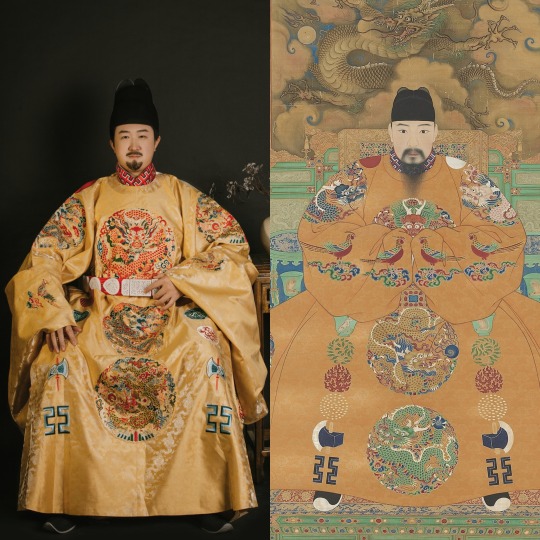




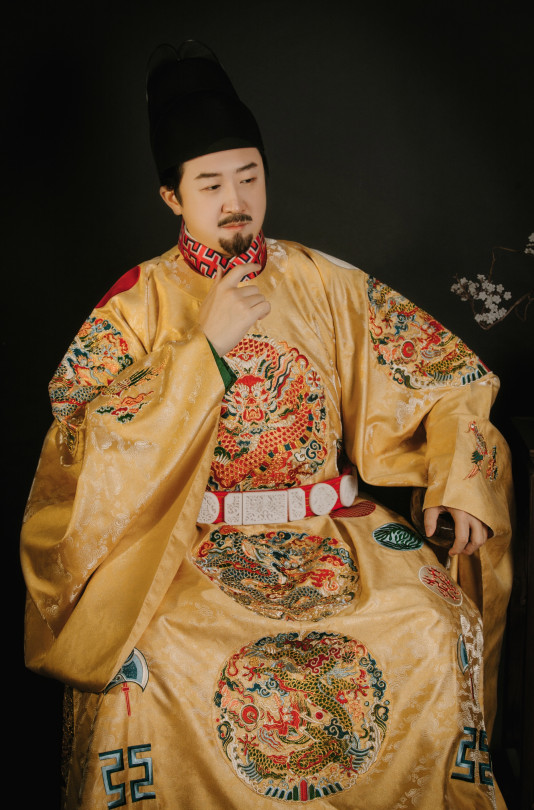

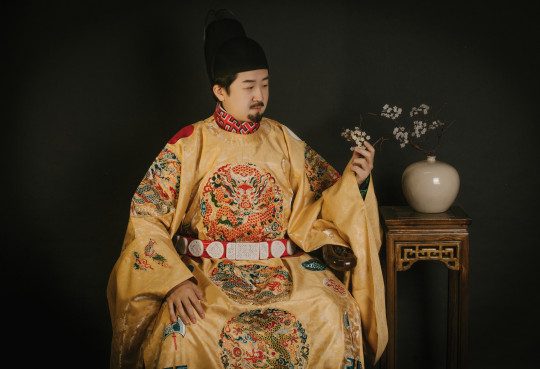



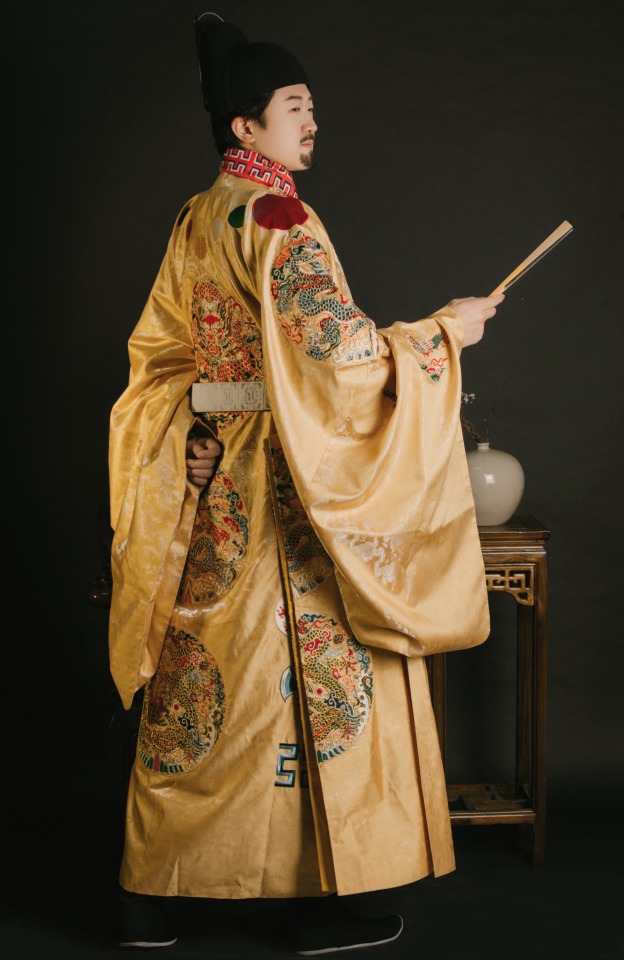
【Ming Dynasty Emperor Portrait Reference】
Palace Portrait of Hongzhi Emperor (30 July 1470 – 9 June 1505)

Posthumous Portrait of Ruizong Emperor (22 July 1476 – 13 July 1519)

Palace Portrait of Jiajing Emperor (16 September 1507 – 23 January 1567)

[Hanfu · 漢服]China Ming Dynasty Emperor Hanfu Based On Ming Dynasty Emperor Portrait
----
十二章纹衮服圆领袍 (The Twelve Ornaments Round collar robe):
The Twelve Ornaments (Chinese: 十二章; pinyin: Shí'èr zhāng) are a group of ancient Chinese symbols and designs that are considered highly auspicious. They were employed in the decoration of textile fabrics in ancient China, which signified authority and power, and were embroidered on china emperor’s robe.

【On the upper Robe】
The sun (日, rì) with the three-legged crow
The moon (月, yuè) with the moon rabbit in it, who is constantly pounding the elixir of life
The Three Stars (星辰, xīngchén), which could also be the Fu Lu Shou stars, which symbolise happiness, prosperity, and longevity
The Sacred Mountains (山, shān), which symbolize stability and tranquility
The Dragon (龍, lóng), symbol of adaptability and strength
The Pheasant (華蟲), which is however the phoenix (鳳凰, fenghuang), symbol of peace and refinement
The dragon and phoenix represent the natural world. In yin and yang terminology, a dragon is male yang and the phoenix a female yin.Therefore, the emperor was often identified as the dragon, while the empress was the phoenix. This was also reflected in the robes they wore.
----

【On the lower robe】
Two Cups (宗彝, zōng yí), which are a sacrificial utensil, sometimes feature patterns containing each a tiger and a monkey, and symbolize faithfulness and respect
A Spray Of Pondweed Or Algae (藻, zǎo), a symbol of brightness and purity
Fire (火, huǒ), which symbolises brightness.
Grains Of Rice (粉米, fěn mǐ), which symbolises nourishment and the country's agriculture, but also wealth
An Axe (黼, fǔ), symbol of courage and resolution, but also executive justice.
The figure 亞 (黻, fú) underneath the axe represents two animals with their backside together. This symbolises the capability to make a clear distinction between right and wrong.
—————————–
📝Recreation Work & 👗Hanfu:@云河千色
🔗Weibo:https://weibo.com/5977615774/L958AiZQh
—————————–
#chinese hanfu#Ming Dynasty#hanfu history#hanfu accessories#hanfu_challenge#chinese traditional clothing#Chinese Style#Chinese Costume#chinese historical fashion#The Twelve Ornaments Round collar robe#十二章纹衮服圆领袍#Ming Dynasty Emperor#Palace Portrait of Hongzhi Emperor#Posthumous Portrait of Ruizong Emperor#Palace Portrait of Jiajing Emperor#云河千色#Round-Collar Robe#漢服#上遥居汉服
216 notes
·
View notes
Text
Events 11.27 (before 1950)
AD 25 – Luoyang is declared capital of the Eastern Han dynasty by Emperor Guangwu of Han.
176 – Emperor Marcus Aurelius grants his son Commodus the rank of "Imperator" and makes him Supreme Commander of the Roman legions.
395 – Rufinus, praetorian prefect of the East, is murdered by Gothic mercenaries under Gainas.
511 – King Clovis I dies at Lutetia and is buried in the Abbey of St Genevieve.
602 – Byzantine Emperor Maurice is forced to watch as the usurper Phocas executes his five sons before Maurice is beheaded himself.
1095 – Pope Urban II declares the First Crusade at the Council of Clermont.
1542 – Palace plot of Renyin year: A group of Ming dynasty palace women fail to murder the Jiajing Emperor, and are executed by slow-slicing.
1727 – The foundation stone to the Jerusalem Church in Berlin is laid.
1809 – The Berners Street hoax is perpetrated by Theodore Hook in the City of Westminster, London.
1815 – Adoption of the Constitution of the Kingdom of Poland.
1830 – Saint Catherine Labouré experiences a Marian apparition.
1835 – James Pratt and John Smith are hanged in London; they are the last two to be executed for sodomy in England.
1839 – In Boston, Massachusetts, the American Statistical Association is founded.
1856 – The Coup of 1856 leads to Luxembourg's unilateral adoption of a new, reactionary constitution.
1863 – American Civil War: Confederate cavalry leader John Hunt Morgan and several of his men escape the Ohio Penitentiary and return safely to the South.
1863 – American Civil War: Battle of Mine Run: Union forces under General George Meade take up positions against troops led by Confederate General Robert E. Lee.
1868 – American Indian Wars: Battle of Washita River: United States Army Lieutenant Colonel George Armstrong Custer leads an attack on Cheyenne living on reservation land.
1895 – At the Swedish–Norwegian Club in Paris, Alfred Nobel signs his last will and testament, setting aside his estate to establish the Nobel Prize after he dies.
1896 – Also sprach Zarathustra by Richard Strauss is first performed.
1901 – The U.S. Army War College is established.
1912 – Spain declares a protectorate over the north shore of Morocco.
1917 – P. E. Svinhufvud becomes the chairman of his first senate, technically the first Prime Minister of Finland.
1918 – The Makhnovshchina is established.
1924 – In New York City, the first Macy's Thanksgiving Day Parade is held.
1940 – In Romania, the ruling Iron Guard fascist party assassinates over 60 of arrested King Carol II of Romania's aides and other political dissidents.
1940 – World War II: At the Battle of Cape Spartivento, the Royal Navy engages the Regia Marina in the Mediterranean Sea.
1942 – World War II: At Toulon, the French navy scuttles its ships and submarines to keep them out of Nazi hands.
1944 – World War II: RAF Fauld explosion: An explosion at a Royal Air Force ammunition dump in Staffordshire kills seventy people.
1945 – CARE (then the Cooperative for American Remittances to Europe) is founded to send CARE Packages of food relief to Europe after World War II.
1 note
·
View note
Text


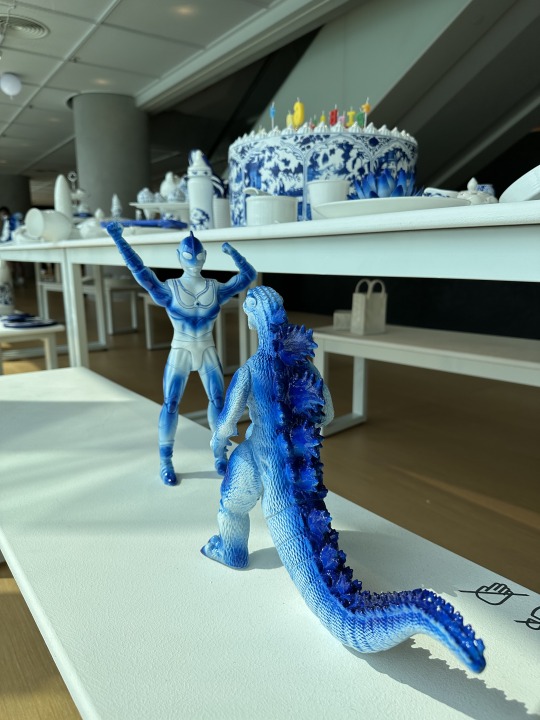
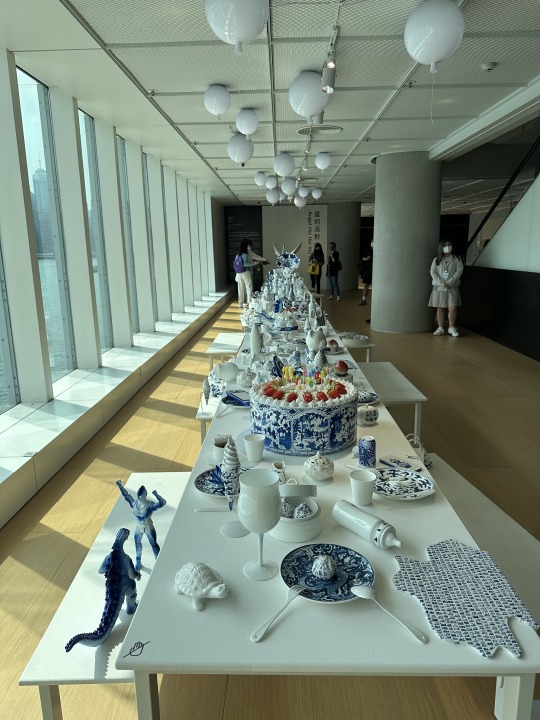
I found these two photos in my phone albums and wanted to share them. They were taken last year (2022) at an exhibition in Hong Kong, China called 'Eternal Enlightenment: The Virtual World of JiaJing Emperor'. 2022 marked the 500th anniversary of the ascension of the JiaJing Emperor from the Ming Dynasty in China, so the Hong Kong Art Museum seized this opportunity to host an exhibition centered around JiaJing.
In this exhibition, what captivated me the most was the porcelain art pieces. Over 500 art items were displayed on a 14-meter-long dining table. It was quite fascinating, allowing visitors to feel as though they were guests at a timeless feast. Moreover, this exhibition felt different from the usual porcelain showcases. Apart from the dignified pieces, there was a jovial and playful vibe, with porcelain made to resemble items like pizzas and donuts. All in all, it was a delightful experience.
It also sparked a thought in me: we shouldn't have a stereotypical impression of anything. Take porcelain, for example; aside from its dignified image, if we imbue it with other vibrant facets of life, it can still shine brilliantly in its own way.
0 notes
Text
vimeo
The Virtual World of Jiajing Emperor - dontbelieveinstyle
0 notes